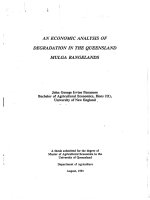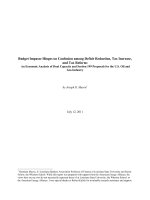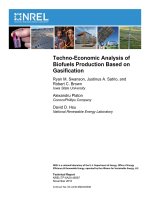Macro Economic Analysis of Coca Cola
Bạn đang xem bản rút gọn của tài liệu. Xem và tải ngay bản đầy đủ của tài liệu tại đây (38.78 KB, 9 trang )
Macro Economic Analysis of Coca Cola
Introduction
The Coca-Cola Company Limited is the world's largest beverage company and is the leading producer and
marketer of soft drinks. Due to the facing of highly competition in the market, the Company used more
than million dollars in the R& D, marketing and production, in order to design a new product to gain a
higher margin. This report is mainly focusing on how Coca-Cola Company Limited uses strategies in order
to competitive in the mature market. Firstly, the issues of the Company will be identified, and then SWOT
analysis of the company will be conducted. After that, evaluation of alternative strategies will be stated
and finally recommendations and implementation will be given.
Background
Coca-Cola Company Limited is the world largest offerer of non-alcoholic beverages and the most valuable
firm in the world. They owned over 300 brands in over 200 countries and serving carbonated soft drink
and non-carbonated beverages such as fruit juice, fruit drink, sports drinks, coffees and bottled water.
Coca-Cola Co. is
operating in their existing brands, and also develops new global and local brands and acquisition of the
global or local brands.
In 2002, the company has launched new brand product including Diet Lemon Coke, Vanilla Coke and large
varieties of fruit taste Fanta including lime, grape, strawberry and passion fruit in Australia. The company
has also acquired many new international water brands such as Danone Waters, Sparklettes, Alhambra and
Evian brands in US. They also continued collaboration with the Walt Disney Company to market children's
soft drinks.
Coca-Cola Company Limited has invested a huge amount in marketing campaign to support their brands.
The aims for these campaigns are to enhance the consumer awareness and consumer preference for a
certain brand. As a result, Coca-Cola Co. has maintained a long-term growth in profitable volume and large
market share in the worldwide non-alcoholic beverage market.
We can write a custom research paper on Coca Cola for you!
Problem or Issue Identification
The non-alcoholic carbonated or non-carbonated drinks have reached the mature market; Coca-Cola Co.
has to develop strategies in order to remain in the strong competitive market.
Situation Analysis
Strength
- Global Soft drink industry leader: Coca-Cola Co. is the world largest bottler. Products sell throughout the
world. It generates $870 million sales in Australia last year. According to the Business Week Magazine, Coca
Cola was listed at NO.1 in the world's 100 most valuable brand in terms of their intangible assets
(Business Week Magazine, 2003).
- Brand recognition - Strong brand name over worldwide and leader in the soft drink industry. Its brand
new is well known in 90% of the world (Allen, 1995).
- Large varieties of product: Besides the carbonated soft drink, Coca Cola Co. has provided other range of
beverages such as water, fruit juices and sport drinks to satisfy different customer's needs. However,
different countries customer may have different preferences, Coca Cola has positioned as a worldwide
brand but it has different strategies for each market.
- Highly distribution: their products are largely distribute in everywhere, customers in over 200 countries
can enjoy the Coca Cola product and consumer 1 billion sales unit globally (PR Newswire, 2003). People
could buy the product in supermarket, convenience store, vending machines, food court, fast food shop,
etc.
- Different age group: Coca-Cola has provided a wide range of products, which can target different group.
For example, Classic Coke target a wide range of customers, Vanilla Coke is heavily target 16-29 years old
and Diet Lemon Coke is slanted 12-20 years old female ( />- Product Innovation: Successful innovation help the achieve of the pricing power. They have set the right
mix between pricing and volume and thus generate profit. An example of successful innovation is the
introduction of Vanilla Coke which was first launched in US on May 2002 and continued to launch in
Canada, Australia and Hong Kong and New Zealand
(Datamonitor plc, 2003).
- Growth of market share: Increase market share by the acquisitions of the other bottling companies - Herb
Coca-Cola, Dr Pepper and Tarpon Springs (Datamonitor company profile, 2003).
Weaknesses
- Competition within the company, as Coca Cola Co. has a wide range of product line such as Coca Cola
Classic, Diet-Coke, Sprite, POWERade, Dr Pepper, Fanta and Aquarius. This will increase the competition
between each other.
- Highly rely on the carbonated beverage: 92% sales of the Coca-Cola Enterprises are come from the Coke
product. Carbonated soft drinks are its core category, however this category has reached mature and
growth slowly in the market. The expected growth of annual sales in the carbonated soft drink category is
3.8%, while the total soft drinks category expected to growth in 4.2% (Datamonitor plc, 2003).
- Limited product range: Comparing with the major competitors PepsiCo and Cadbury Schweppes, Coca-
Cola has less product range such as snacks division. Therefore, they are relatively weak in competitive in
the food and drinks market (Datamonito plc.2003).
- Vest amount of investment in the marketing campaigns: Coca-Cola has put a huge amount of money in
investing the marketing campaigns. However, it rivals are also invested large amount in marketing, thus the
result of the campaigns are less effective (Datamonito plc, 2003).
Opportunities
- World wide economic and population growth: this will sustain the growth of the beverage market as the
demand of product increase.
- Soft
drinks dominate the Australian beverage market: 2/3 of the beverage market is dominated by the soft
drinks and fruit juices comprise 13.1%. More of the sales are depending on the carbonate soft drinks.
Threats
- Political and economic instability in many developing countries - Coca Cola has recently report sales
decline in the region of Indonesia and Thailand because of the economic weaken and lower the consumer
purchasing power (Mclean, 1998).
- Competition in national, regional and global soft drink companies - they have a threat on substitutes. As
there is only a weak commitment between Cola and consumer, their switching cost is low. It is possibly
substitute by others beverage such as coffee, juice, tea, milk and hot chocolate ("Cola Wars", 1991).
- Consumer attitudes changes - Although soft drinks are dominated the Australian beverage market, there
is a significant growth in the fruit juices and bottled water market due to the increase awareness of the
health concern (Food Australia, 2003). Scientists The Lancet mentioned in the British medical journal that
consumption of soft drinks would have a high risk of getting obesity in the 11-12 years old child. This
significantly loss the contract with the school (Eckelbecker, 2003).
Generation and Evaluation of Alternative Strategies
Characterises of Mature Market
In the mature market, competitions are intensive. There are several or many competitors compete for the
position. Company have to spend lots of expense in maintain or optimise their position. As a result,
there are product proliferation, price competition, intensive competitive promotional activity, the erosion
of margins, and slackening sales growth potential (Cravens et al, 2000). Therefore strategies in product
management, distribution, pricing and promotional activity are developed.
In this case, Strategic Market Planning Process (appendix A) act as the model to identify Coca-Cola
Company strategies was used in the competition of mature market. The first step has to be done is the
SWOT analysis. This identifies the Coca-Cola Business Performance, Market Attractiveness and Competitive
Advantage.
Then a portfolio analysis was done (appendix C). Coca-cola has a strong competitive advantage as it is a
global soft drink leader which is very successful in the existing beverage market. Almost 90% of the world
has recognised the brand with good reputation. Company also have huge resources in doing R&D and
Marketing. On the other hand, the competition in the beverage market is intensive, the major competitor
is the Pepsi Co and they have strong resources in for the marketing, thus the effectiveness of Coca-Cola's
marketing effectiveness is decreased. Company should actively attract the customer to prevent of
switching brand. Therefore, Coca-Cola has adopted both defensive and offensive strategies to competitive
in this mature beverage market (appendix B).
Offensive Strategic Market
Offensive strategies are used to produce sales growth and improve share position and future profit
performance.
Product Development
Product
development strategy aims new or improved products at the existing markets. An awareness of the
present market's are required for the company to recognise new ways to satisfy the customers.
In 2002, Australia's Coca Cola has launched 18 new beverages such as Vanilla Coke, Diet Lemon Coke, New
flavour POWERade and Cherry Coke in 2003. Targe market of the Vanilla Coke and Diet Lemon Coke is
heavily target 16-29 and 12-20 years old female (
respectively. The consumption of the Vanilla Coke is approximately 6 million unit case in the first 3 months
launched. In 2003 early April, Fanta expand its product line in producing some new flavour carbonated soft
drinks which including the original orange flavour and also grape, lime, strawberry and passionfruit with
new packaging splash bottle. The product target market is the 13 to 17 teens. This product development
has generated positive volume and pricing growth in many countries such as Europe and Thailand
(www.coca-cola.com). They are helpful in generating profit and capture the market share.
New flavour Fanta launch by Coca-Cola Company
In 2001, Japan's Coca-Coke Company Limited first launched a new product line called "Qoo" which is a
non-carbonated fruit drink product line. It is an innovation and totally distinct from the classic product
image. The drink has an animation character called Qoo and showed in every bottle. The character of Qoo
is cute and happy, aims to target the child and young people. Initially, there are only









